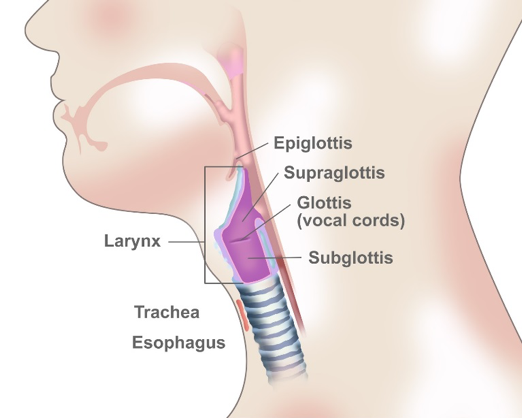Laryngeal Cancer Overview
Laryngeal cancer is a disease in which malignant (cancer) cells form in the tissues of the larynx--the part of the throat between the base of the tongue and the trachea. The larynx contains the vocal cords, which vibrate and make sound when air is directed against them. The sound echoes through the pharynx, mouth, and nose to make a person’s voice.
There are three main parts of the larynx, which include:
- Supraglottis - the upper part of the larynx above the vocal cords, including the epiglottis, which is the flap that covers the trachea when swallowing so that food does not enter the lungs.
- Glottis - the middle part of the larynx where the vocal cords are located.
- Subglottis - the lower part of the larynx between the vocal cords and the trachea (windpipe).

Laryngeal cancer is a type of head and neck cancer that forms in squamous cells, which are the thin, flat cells that line the inside of the larynx.
Risk Factors of Laryngeal Cancer
Anything that increases your risk of getting a disease is called a risk factor. Risk factors of laryngeal cancer may include:
- Smoking and/or chewing tobacco
- Moderate or heavy alcohol use (more than one drink a day)
- Poor nutrition
- Human papillomavirus (HPV) infection
- Genetic syndromes (inherited gene mutations)
- Workplace exposures to certain fumes and chemicals
- Gender (more common in men than women)
- Age (more common among patients age 65 and older)
- Race (more common among African Americans and Caucasians)
- Gastroesophageal reflux disease (GERD)
Keep in mind that having a risk factor, or even several of them, does not mean that you will get laryngeal cancer. Likewise, many people who get the disease may have few or no known risk factors.
Laryngeal Cancer Signs and Symptoms
There are several signs and symptoms that could be related to laryngeal cancer; however, it is important to remember that they can also be symptoms for other diseases. See your doctor if you have:
- A change in your voice, such as unexplained hoarseness
- A lump in the neck
- Persistent sore throat
- Ear pain not caused by an ear infection or other condition
- Pain or difficulty when swallowing
Again, these could be symptomatic of something other than cancer. With that said, if any of these symptoms last for more than three weeks, it is a good idea to be checked by a doctor. If it is cancer, early detection can give you better treatment results.

